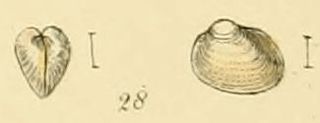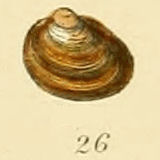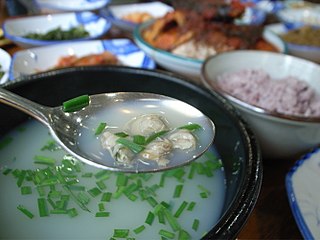
The giant clams are the members of the clam genus Tridacna that are the largest living bivalve mollusks. There are actually several species of "giant clams" in the genus Tridacna, which are often misidentified for Tridacna gigas, the most commonly intended species referred to as “the giant clam”.

Corbicula fluminea is a species of freshwater clam native to eastern Asia which has become a successful invasive species throughout North America, South America, and Europe. Corbicula fluminea is commonly known in the west as the Asian clam or Asiatic clam. In Southeast Asia, C. fluminea is known as the golden clam, prosperity clam, pygmy clam, or good luck clam.

Pisidium casertanum, the pea cockle or pea clam, is a minute freshwater bivalve mollusc of the family Sphaeriidae.
Pisidium moitessierianum is a species of minute freshwater clam. It is an aquatic bivalve mollusc in the family Sphaeriidae.

Pisidium milium is a species of very small freshwater bivalve in the family Sphaeriidae, the fingernail clams and pea clams.
Pisidium supinum is a species of minute freshwater clam, a pea clam, an aquatic bivalve mollusc in the family Sphaeriidae

Pisidium pseudosphaerium is a species of freshwater bivalve from family Sphaeriidae.

Pisidium subtruncatum is a species of pill clam, a minute freshwater bivalve in the family Sphaeriidae.

Pisidium nitidum, the shining pea clam, is a species of minute freshwater clam, an aquatic bivalve mollusc in the family Sphaeriidae, the pea clams and fingernail clams.

Sphaeriidae is a family of small to minute freshwater bivalve molluscs in the order Sphaeriida. In the US, they are commonly known as pea clams or fingernail clams.

Pisidium is a genus of very small or minute freshwater clams known as pill clams or pea clams, aquatic bivalve molluscs in the family Sphaeriidae, the pea clams and fingernail clams.

Pisidium pulchellum, the iridescent pea mussel, is a minute species of pea clam, a freshwater bivalve in the family Sphaeriidae.

Pisidium conventus, the arctic-alpine pea clam, is a species of freshwater bivalve from the family Sphaeriidae.
Pisidium artifex is a species of freshwater clam in the family Sphaeriidae. It is endemic to Kenya, where it is known only from Mount Kenya. It lives in water bodies at an elevation of 4,300 metres.

Jaecheop-guk (재첩국) is a clear guk (soup) made with jaecheop, small freshwater marsh clams native to Korea. The soup is considered a local specialty of Yeongnam and Honam regions, where jaecheop are harvested in the lower reaches of Nakdong River and Seomjin River.

William Henry Heard is a malacologist, and an authority on freshwater mollusks, especially freshwater pelecypods (clams). He is an emeritus professor in the Department of Biological Sciences, at Florida State University.












